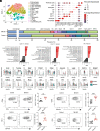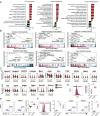NMDAR antagonists suppress tumor progression by regulating tumor-associated macrophages
- PMID: 37967215
- PMCID: PMC10666127
- DOI: 10.1073/pnas.2302126120
NMDAR antagonists suppress tumor progression by regulating tumor-associated macrophages
Abstract
Neurotransmitter receptors are increasingly recognized to play important roles in anti-tumor immunity. The expression of the ion channel N-methyl-D-aspartate receptor (NMDAR) on macrophages was reported, but the role of NMDAR on macrophages in the tumor microenvironment (TME) remains unknown. Here, we show that the activation of NMDAR triggered calcium influx and reactive oxygen species production, which fueled immunosuppressive activities in tumor-associated macrophages (TAMs) in the hepatocellular sarcoma and fibrosarcoma tumor settings. NMDAR antagonists, MK-801, memantine, and magnesium, effectively suppressed these processes in TAMs. Single-cell RNA sequencing analysis revealed that blocking NMDAR functionally and metabolically altered TAM phenotypes, such that they could better promote T cell- and Natural killer (NK) cell-mediated anti-tumor immunity. Treatment with NMDAR antagonists in combination with anti-PD-1 antibody led to the elimination of the majority of established preclinical liver tumors. Thus, our study uncovered an unknown role for NMDAR in regulating macrophages in the TME of hepatocellular sarcoma and provided a rationale for targeting NMDAR for tumor immunotherapy.
Keywords: NMDA receptor; ROS; macrophages; tumor; tumor microenvironment.
Conflict of interest statement
X.L. is an employee of OriCell Therapeutics. W.C.D. is a member of the EpimAb Biotherapeutics scientific advisory board and holds patents related to the Receptor Activator of Nuclear Factor-κ B Ligand (RANKL) pathway. No potential conflicts of interest were disclosed by the other authors.
Figures






References
Publication types
MeSH terms
Substances
Grants and funding
LinkOut - more resources
Full Text Sources
Medical

